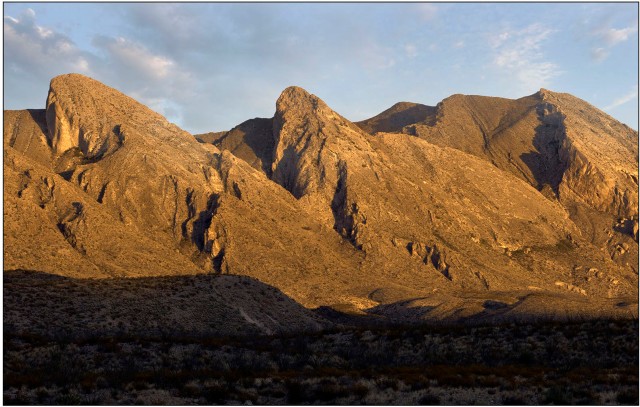The Chihuahuan Desert is the largest desert in North America, enclosing over 200,000 square miles in the US. It is a “high desert” with altitudes mostly ranging from 2,000 to 5,500 feet. The terrain consists mostly of expansive basins broken by numerous small mountain ranges. The mountain ranges serve as “islands” in the desert. They capture passing moisture and feed it into a diverse network of underground streams, rivers, and lakes. The large basins contain frequent, though mostly ephemeral streams, lakes, arroyos and tinajas that create riparian habitat which greatly adds to the diversity of our flora and fauna. The basins are dominated by low desert shrubs and, to a lesser extent, grasslands. Grasslands were probably the dominant feature of the area in the past, but overgrazing and a severe drought in the 50s allowed desert scrub to invade the grasslands, and these plants now dominate most of the area.
The Chihuahuan Desert gets around 10 inches of rain per year – slightly more rain than most of the southern Great Basin, the Mojave, or the Sonoran desert, but vegetation is surprisingly dense and extensive here. This is due to the fact that most of our rain occurs from mid- to late-summer. The late-summer rains lower the annual soil temperature and permit many plants to live here that could not otherwise do so.
There are two large parks in the area, the Big Bend National Park and the Big Bend Ranch State Park. The national park is the grandest park. The state park is more representative of the Chihuahuan Desert as a whole. Most of the material in this blog comes from the state park.
The Big Bend Ranch State Park is the largest park in the state’s system. It contains over 311,000 acres. Though it is a park, it is also a working ranch; the park maintains herds of longhorn cattle and a healthy string of horses which are used to work them. All the horses spend most of their time wandering in the wild, but all are tame and ready to carry visitors into parts of the park that cannot be reached by vehicle.
The BBRSP is also home to the “Solitario,” one of the largest laccoliths in the world. Circular in form, it is over 9 miles in diameter and encloses more than 35 square miles of country. Located on the far East side of the park, the Solitario is so remote, and so rugged, it has not even been ranched extensively. Ranchers complained that even their goats could not reach much of the grass in the area.
The Big Bend Ranch is a priceless national treasure. I hope you enjoy exploring it with me as I seek to gain a better understanding of the area.








Pingback: Thriving in the desert « Big Bend Now
This is Absolutely Lovely! The pictures are Amazing! I love the whole look of the site!